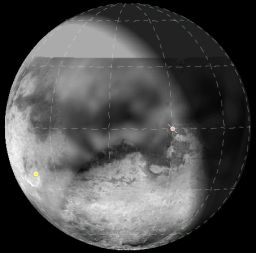Titan-4 Mission Description and other products

View of Titan from Cassini during ISS' medium range coverage mapping (sub-spacecraft point=1.1N, 21.3W). The orange point marks the sub-Saturnian point and the yellow point marks the sub-Solar point. The plot was generated in GISS' Titan 24 software. The map is derived from ISS map released earlier this month (ask for full version used here, just adds blank space north of 34N). The full version of above plot is available (as well as one with surface feature labels; cratr2 is the 80-km wide crater found by RADAR, Cratr3 is a dark ring found by ISS during T0). the data for plot was obtained from Mission description document.
JPL has released the mission description for next week's Titan flyby over the sub-Saturnian hemisphere. The usual goodies are include like instrument goals for the flyby, timeline of events, and the playback table to you (and I) can have a reasonable idea of when the data will be played back. From the looks of it, the playback for this flyby will take place during mid-morning here in Tucson so I don't have to stay up and have to process images till 3 in the morning like some of the last few flybys.
Here are some highlights in the flyby goals:
- ISS will image the northern sub-Saturnian hemisphere of Titan with medium resolution narrow angle imaging combined with wide angle camera photometry. ISS will also have some high resolution imaging specifically targeting the surface covered in T3 closest approach RADAR SAR. From the screen cap on page 5, it looks like ISS may capture Saturn over Titan's limb in a CIRS ride-along.
- UVIS observations will map airglow emission lines from Nitrogen and Carbon and measure reflected sunlight from Titan's haze to study the properties of haze particles.
- CIRS observations will include limb profiles to measure vertical profiles in temperature and to look for aerosols, as well as nadir observations to measure the distribution of Carbon monoxide, Hydrogen cyanide, and methane.
- RPWS will continue to search for lightning as well as understanding the plasma interactions with Titan's atmosphere and the magnetosphere in Titan's vicinity.
- VIMS will carry out observations of Titan's cloud features (if they show up this orbit...). VIMS will also carry out compositional mapping of Titan's northern sub-Saturnian hemisphere.
- RADAR will preform radiometry and scatterometry observations complimentary to those carried out on Ta.
T4 Closest Approach is on March 31 at 2:18 pm MST.
UPDATE: added plot above.


0 Comments:
Post a Comment
<< Home